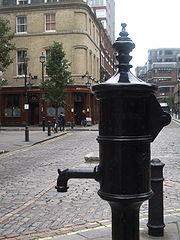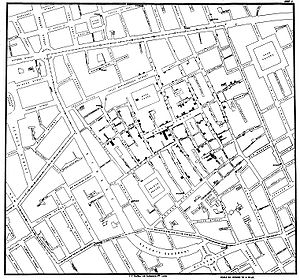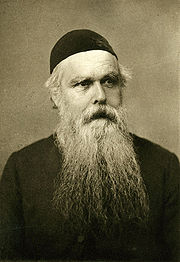
1854 Broad Street cholera outbreak
Encyclopedia

Outbreak
Outbreak is a term used in epidemiology to describe an occurrence of disease greater than would otherwise be expected at a particular time and place. It may affect a small and localized group or impact upon thousands of people across an entire continent. Two linked cases of a rare infectious...
of cholera
Cholera
Cholera is an infection of the small intestine that is caused by the bacterium Vibrio cholerae. The main symptoms are profuse watery diarrhea and vomiting. Transmission occurs primarily by drinking or eating water or food that has been contaminated by the diarrhea of an infected person or the feces...
that occurred near Broad Street (now renamed Broadwick Street
Broadwick Street
Broadwick Street is a street in Soho, City of Westminster, London. It runs for 0.18 mile approximately west-east between Marshall Street and Wardour Street, crossing Berwick Street....
) in Soho
Soho
Soho is an area of the City of Westminster and part of the West End of London. Long established as an entertainment district, for much of the 20th century Soho had a reputation for sex shops as well as night life and film industry. Since the early 1980s, the area has undergone considerable...
district of London
London
London is the capital city of :England and the :United Kingdom, the largest metropolitan area in the United Kingdom, and the largest urban zone in the European Union by most measures. Located on the River Thames, London has been a major settlement for two millennia, its history going back to its...
, England
England
England is a country that is part of the United Kingdom. It shares land borders with Scotland to the north and Wales to the west; the Irish Sea is to the north west, the Celtic Sea to the south west, with the North Sea to the east and the English Channel to the south separating it from continental...
in 1854. This outbreak is best known for John Snow
John Snow (physician)
John Snow was an English physician and a leader in the adoption of anaesthesia and medical hygiene. He is considered to be one of the fathers of epidemiology, because of his work in tracing the source of a cholera outbreak in Soho, England, in 1854.-Early life and education:Snow was born 15 March...
's study of the outbreak and his discovery that cholera
Cholera
Cholera is an infection of the small intestine that is caused by the bacterium Vibrio cholerae. The main symptoms are profuse watery diarrhea and vomiting. Transmission occurs primarily by drinking or eating water or food that has been contaminated by the diarrhea of an infected person or the feces...
is spread by contaminated water.
Background
In the mid-19th century, the Soho district of London had a serious problem with filth due to the large influx of people and a lack of proper sanitary services: The London sewer system had not reached Soho. Many cellars (basements) had cesspools of night soilNight soil
Night soil is a euphemism for human excrement collected at night from cesspools, privies, etc. and sometimes used as a fertilizer. Night soil is produced as a result of a waste management system in areas without community infrastructure such as a sewage treatment facility, or individual septic...
underneath their floorboards. Since the cesspools were overrunning, the London government decided to dump the waste into the River Thames
River Thames
The River Thames flows through southern England. It is the longest river entirely in England and the second longest in the United Kingdom. While it is best known because its lower reaches flow through central London, the river flows alongside several other towns and cities, including Oxford,...
. This action contaminated the water supply, leading to the cholera outbreak.
Outbreak
On 31 August 1854, after several other outbreaks had already occurred elsewhere in the city, a major outbreak of cholera struck Soho. John Snow, the physician who linked the outbreak to contaminated water, later called it "the most terrible outbreak of cholera which ever occurred in the United Kingdom."Over the next three days 127 people on or near Broad Street died. In the next week, three quarters of the residents had fled the area. By 10 September, 500 people had died and the mortality rate was 12.8 percent in some parts of the city. By the end of the outbreak 616 people had died.
John Snow investigation

Miasma theory of disease
The miasma theory held that diseases such as cholera, chlamydia or the Black Death were caused by a miasma , a noxious form of "bad air"....
that stated that diseases such as cholera or the Black Death were caused by pollution or a noxious form of "bad air". The germ theory was not widely accepted by this time, so Snow was unaware of the mechanism by which the disease was transmitted, but evidence led him to believe that it was not due to breathing foul air. He first publicized his theory in an essay On the Mode of Communication of Cholera in 1849. In 1855 a second edition was published, with a much more elaborate investigation of the effect of the water-supply in the Soho
Soho
Soho is an area of the City of Westminster and part of the West End of London. Long established as an entertainment district, for much of the 20th century Soho had a reputation for sex shops as well as night life and film industry. Since the early 1980s, the area has undergone considerable...
, London
London
London is the capital city of :England and the :United Kingdom, the largest metropolitan area in the United Kingdom, and the largest urban zone in the European Union by most measures. Located on the River Thames, London has been a major settlement for two millennia, its history going back to its...
epidemic of 1854.
By talking to local residents (with the help of Reverend Henry Whitehead
Reverend Henry Whitehead
The Reverend Henry Whitehead was a Church of England cleric and the assistant curate at St. Luke's church in Soho, London during the 1854 cholera outbreak....
), he identified the source of the outbreak as the public water pump on Broad Street (now Broadwick Street
Broadwick Street
Broadwick Street is a street in Soho, City of Westminster, London. It runs for 0.18 mile approximately west-east between Marshall Street and Wardour Street, crossing Berwick Street....
). Although Snow's chemical and microscope examination of a sample of the Broad Street pump water was not able to conclusively prove its danger, his studies of the pattern of the disease were convincing enough to persuade the local council to disable the well pump by removing its handle. Although this action has been popularly reported as ending the outbreak, the epidemic may have already been in rapid decline, as explained by Snow himself:
Snow later used a spot map to illustrate how cases of cholera were centred around the pump. He also made a solid use of statistics
Statistics
Statistics is the study of the collection, organization, analysis, and interpretation of data. It deals with all aspects of this, including the planning of data collection in terms of the design of surveys and experiments....
to illustrate the connection between the quality of the source of water and cholera cases. He showed that the Southwark and Vauxhall Waterworks Company
Southwark and Vauxhall Waterworks Company
The Southwark and Vauxhall Waterworks Company was a utility company supplying water to parts of south London in England. The company was formed by the merger of the Southwark and Vauxhall Water Companies in 1845 and became part of the publicly-owned Metropolitan Water Board in 1903.-Southwark Water...
was taking water from sewage-polluted sections of the Thames and delivering the water to homes with an increased incidence of cholera. Snow's study was a major event in the history
History
History is the discovery, collection, organization, and presentation of information about past events. History can also mean the period of time after writing was invented. Scholars who write about history are called historians...
of public health
Public health
Public health is "the science and art of preventing disease, prolonging life and promoting health through the organized efforts and informed choices of society, organizations, public and private, communities and individuals" . It is concerned with threats to health based on population health...
and health geography
Health geography
Health geography is the application of geographical information, perspectives, and methods to the study of health, disease, and health care.- Overview :...
, and can be regarded as the founding event of the science
Science
Science is a systematic enterprise that builds and organizes knowledge in the form of testable explanations and predictions about the universe...
of epidemiology
Epidemiology
Epidemiology is the study of health-event, health-characteristic, or health-determinant patterns in a population. It is the cornerstone method of public health research, and helps inform policy decisions and evidence-based medicine by identifying risk factors for disease and targets for preventive...
.
In Snow's own words:
It was discovered later that this public well had been dug only three feet from an old cesspit
Cesspit
A cesspit, or cesspool is a pit, conservancy tank, or covered cistern, which can be used to dispose of urine and feces, and more generally of all sewage and refuse. It is a more antiquated solution than a sewer system. Traditionally, it was a deep cylindrical chamber dug into the earth, having...
that had begun to leak fecal bacteria. A baby who had contracted cholera from another source had its nappies
Diaper
A nappy or a diaper is a kind of pant that allows one to defecate or urinate on oneself discreetly. When diapers become soiled, they require changing; this process is often performed by a second person such as a parent or caregiver...
(diapers) washed into this cesspit, the opening of which was under a nearby house that had been rebuilt farther away after a fire had destroyed the previous structure, and the street was widened by the city. It was common at the time to have a cesspit under most homes. Most families tried to have their raw sewage collected and dumped in the Thames to prevent their cesspit from filling faster than the sewage could decompose into the soil.
Henry Whitehead involvement

Reverend Henry Whitehead
The Reverend Henry Whitehead was a Church of England cleric and the assistant curate at St. Luke's church in Soho, London during the 1854 cholera outbreak....
was an assistant curate
Curate
A curate is a person who is invested with the care or cure of souls of a parish. In this sense "curate" correctly means a parish priest but in English-speaking countries a curate is an assistant to the parish priest...
at St. Luke's church in Soho
Soho
Soho is an area of the City of Westminster and part of the West End of London. Long established as an entertainment district, for much of the 20th century Soho had a reputation for sex shops as well as night life and film industry. Since the early 1980s, the area has undergone considerable...
, London
London
London is the capital city of :England and the :United Kingdom, the largest metropolitan area in the United Kingdom, and the largest urban zone in the European Union by most measures. Located on the River Thames, London has been a major settlement for two millennia, its history going back to its...
, during the 1854 cholera
Cholera
Cholera is an infection of the small intestine that is caused by the bacterium Vibrio cholerae. The main symptoms are profuse watery diarrhea and vomiting. Transmission occurs primarily by drinking or eating water or food that has been contaminated by the diarrhea of an infected person or the feces...
outbreak.
A former believer in the miasma theory of disease
Miasma theory of disease
The miasma theory held that diseases such as cholera, chlamydia or the Black Death were caused by a miasma , a noxious form of "bad air"....
, Whitehead worked to disprove false theories, eventually focusing on John Snow
John Snow (physician)
John Snow was an English physician and a leader in the adoption of anaesthesia and medical hygiene. He is considered to be one of the fathers of epidemiology, because of his work in tracing the source of a cholera outbreak in Soho, England, in 1854.-Early life and education:Snow was born 15 March...
's idea that cholera spreads through water contaminated by human waste. Snow's work, particularly his maps of the Soho area cholera victims, convinced Whitehead that the Broad Street pump was the source of the local infections. Whitehead then joined with Snow in tracking the contamination to a faulty cesspool and the outbreak's index case.
Whitehead's work with Snow combined demographic
Demographics
Demographics are the most recent statistical characteristics of a population. These types of data are used widely in sociology , public policy, and marketing. Commonly examined demographics include gender, race, age, disabilities, mobility, home ownership, employment status, and even location...
study with scientific observation, setting important precedent for the burgeoning science of epidemiology
Epidemiology
Epidemiology is the study of health-event, health-characteristic, or health-determinant patterns in a population. It is the cornerstone method of public health research, and helps inform policy decisions and evidence-based medicine by identifying risk factors for disease and targets for preventive...
.
See also
- Filippo PaciniFilippo PaciniFilippo Pacini was an Italian anatomist, posthumously famous for isolating the cholera bacillus Vibrio cholerae in 1854, well before Robert Koch's more widely accepted discoveries thirty years later....
- The Ghost MapThe Ghost MapThe Ghost Map: The Story of London's Most Terrifying Epidemic - and How it Changed Science, Cities and the Modern World is a book by Steven Berlin Johnson in which he describes the most intense outbreak of cholera in Victorian London - and what it means to us today, from the way we understand...
- Great Stink
- Joseph BazalgetteJoseph BazalgetteSir Joseph William Bazalgette, CB was an English civil engineer of the 19th century. As chief engineer of London's Metropolitan Board of Works his major achievement was the creation of a sewer network for central London which was instrumental in relieving the city from cholera epidemics, while...
- William BuddWilliam BuddWilliam Budd was an English physician and epidemiologist known for recognizing the contagiousness of infectious diseases. He recognized that the "poisons" involved in infectious diseases multiplied in the intestines of the sick, appeared in the excretions of the sick, and could then be...

